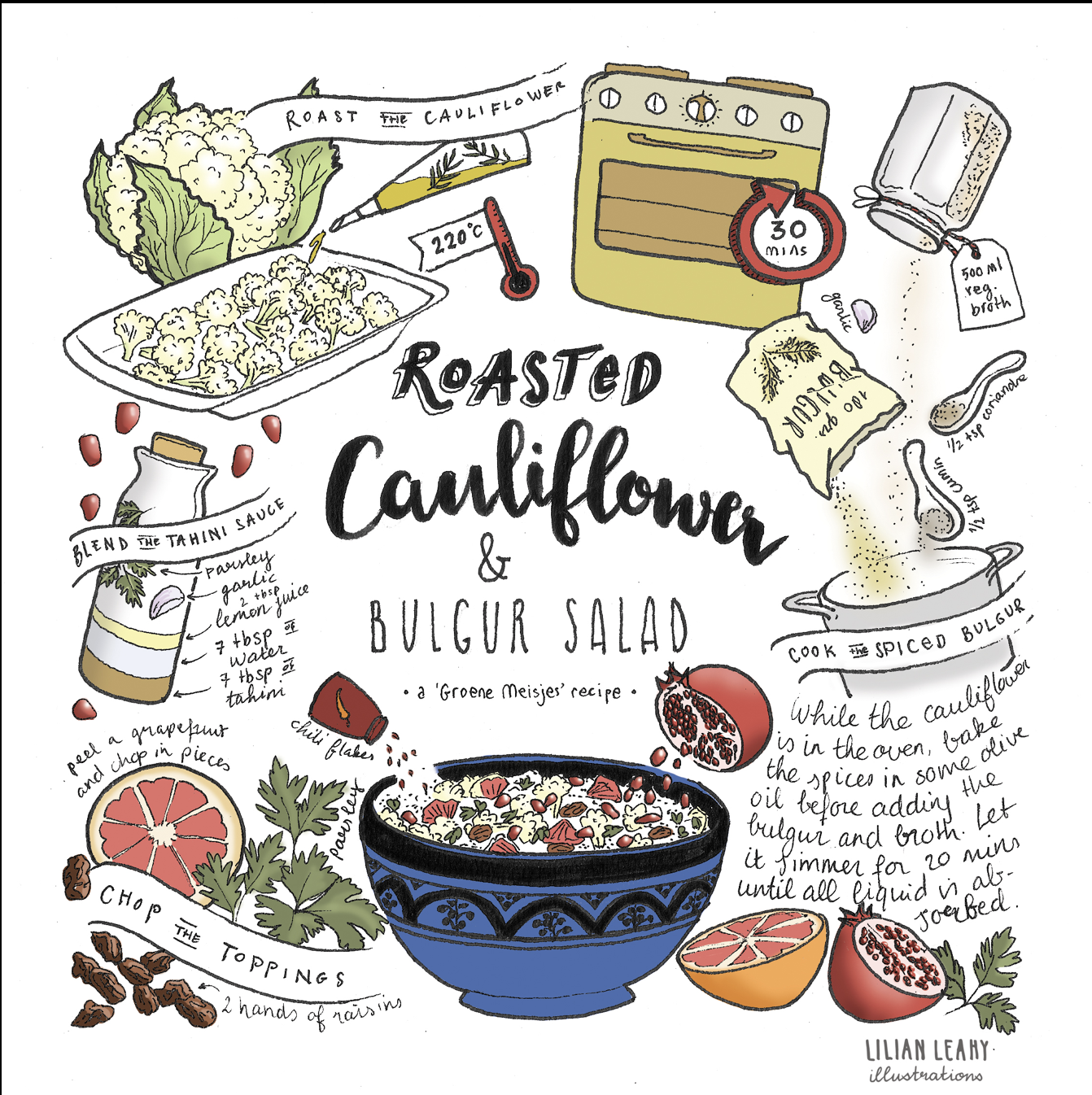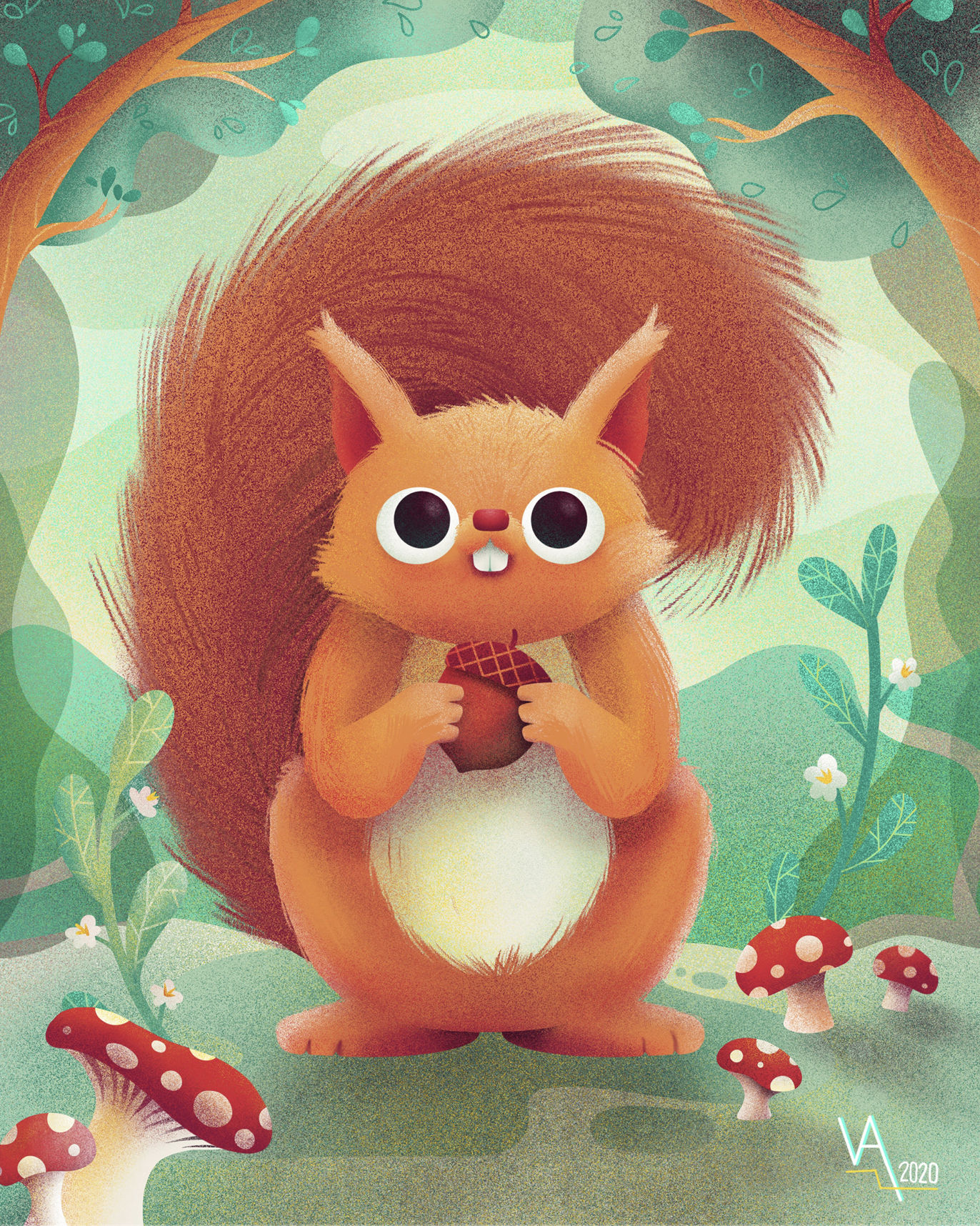Find examples of self-directed projects set by illustrators. What sort of brief did they set themselves?
It seemed surprisingly difficult to find many illustrators who list personal projects on their online portfolios, although I am sure that this is not a true representation as, in the past, I have noticed that many do indeed have examples of this type of work available for viewing. Some of the illustrators that did have this kind of material on show can be found below.
The illustrator Lilian Leahy has a selection of personal projects on her website. Some of these are based on online challenges, such as Inktober, whilst others have been devised by Leahy herself. Examples of the latter include ‘Comic drawings about small things in my life‘, in which Leahy drew a visual representation of daily events in her life in the form of a comic strip or cartoon, rather than writing these in a journal; or ‘Illustrated vegan recipes‘ which are visual instructions of how to make a selection of vegan meals, in one illustration.

Although Leahy does not go into detail about the brief she set for these projects, I would guess that she came up with an idea (or a title) and thought she would pursue it, rather than explicitly writing down the requirements of the projects. She may have had a particular medium choice, style and colour scheme in mind prior to starting, but I do not think she would have pre-planned her intentions in as great depth and detail as she might have done for a client project.
An example of an ongoing personal project by the illustrator Keith Robinson is called the ‘Liminal Project‘, in which he is looking into the transitional space between the human and non-human world. This is a subject that has always fascinated Robinson and, on his daily walks, he pays attention to his surroundings, which he then translates into thumbnail drawings in his sketchbook. He uses these as reference for more finished pieces of work based on the theme of Liminal.
I have not added any images because Robinson requests that his images are not used without written consent.
Robinson has also produced a small book that is made up of 1 inch square pen drawings based on the same theme, alongside a single word that the reader can link to the accompanying drawing as they interpret it. This latter output of the project was based on a challenge set by The House of Illustration in 2018, in which participants were tasked with producing a drawing everyday for 30 days, but it must be within a 1 inch square.
The Liminal Project is clearly a very personal one that Robinson is passionate about. As with the previous example, I do not believe that he wrote out a specific brief for the project, with all the requirements listed as he might receive from a client, but rather decided to further explore an idea that had evolved, and continues to evolve, in his mind. Indeed, he applied his theme to an online challenge set by The House of Illustration, which I found to be quite an inspiring way of adapting an idea/project in an unexpected way.
A simply devised personal project by the illustrator Vanessa Appleby developed out of experimenting with her newly purchased iPad Pro. This has resulted in a range of different illustrations that showcase her skills using digital media.

This project by Appleby demonstrates how just having a new medium to work with play with (whether that be analogue or digital) can result in a whole series of illustrations. It is fairly clear that she did not set herself a specific brief for this project, but rather just was not scared to experiment and see what happened.
Final Thoughts
From the examples of self-directed projects I have found for this Research Point, as well as previous examples I have come across in the past, I believe there are two main elements that need to be evident in order for a personal project to be a success. Firstly, and perhaps rather obviously, there needs to be at least some form of an idea that has potential to be developed. Secondly, and this is the one I struggle with for various reasons, there has to be the motivation to pursue it.
There are many benefits that can be found through undertaking personal projects, such as:
- learning new skills – this could be through a tutorial or the acquiring of a new type of medium.
- practicing techniques you already use – regular practice and learning is very important to keep your skills fresh and up to date.
- having the opportunity to experiment, where the outcome does not matter as much as it may well do in a client-set brief.
- producing material that may be worthy of being added to an online portfolio.
- providing a focus when there is no other work on offer.
- having the enjoyment and freedom of just producing work for yourself rather than the pressure of a client-set brief or coursework.
Reflecting on self-directed projects in the context of my own work, I find that I have countless, imaginative ideas, but very few of these get taken further, which I find quite depressing. There are a number of reasons that this is the case (the majority of which are just poor excuses), which include:
- lack of self-motivation and belief – if I know I have to do something, I will do it with 100% effort, but once I have the opportunity to start doubting its worth and believing ‘there is no point’, I find it very difficult to get out of that mindset.
- poor time management – I have a very regimented schedule, but I still find it difficult to set aside time to undertake personal projects – I do not know why this is.
- distractions – I find it very easy to become distracted (especially working at home (which I like), but not being separate from the rest of the household) and so my concentration is not always 100% focused on what it should be. This is even more of an issue at the moment due to an ongoing personal situation. This is definitely an area I need to work out a remedy for in the near future.
- overwhelmed by choice – I find it very challenging to focus on one particular area of learning illustration (there is too much choice and I am terrible at making decisions) and because there is no structure I end up dipping in and out of different tutorial themes, for example, but never spend enough time to learn about each on in depth. This results in a lack of improvement and producing similar, often mediocre, work all the time.
I used to really like having a timetable which would have set times and topics that I would study each day. There were certain targets and deadlines that I had to meet, with regular input from teachers. This routine would motivate me as I knew I was making progress and my work would improve. This, in turn, would motivate me to undertake work in my own time (which I had more of then). Sometimes, I feel that I would have benefited from attending an in- person illustration course as I would have had the opportunity to experiment more and possibly be held more to account.
Going forward, I will try to devise some ideas for self-directed projects and also seriously consider some of the online challenges, such as the 30 day, 1-inch drawings demonstrated by Keith Robinson.
Bibliography
Appleby, V. (n.d.) Vanessa Appleby. Available at: https://vanessaappleby.com/ (Accessed 25 January 2025).
House of Illustration (n.d.) House of Illustration. Available at: https://www.houseofillustration.org.uk (Accessed 25 January 2025)).
Leahy, L. (2024) Personal Projects – Lilian Leahy. Available at: https://lilianleahy.com/project-type/personal-projects/ (Accessed 25 January 2025)).
Robinson, K. (n.d.) Keith Robinson Illustration – Liminal Project. Available at: https://keithrobinson.co.uk/liminal (Accessed 25 January 2025)).